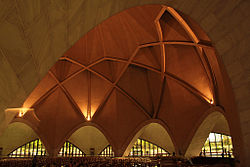
The Lotus Temple, located in Delhi, India, is completed in 1986. Notable for its Lotus flower shape, it has become a prominent attraction in the city. Like all Houses of Worship, the Lotus Temple is open to all. The sacred writings of not only the Bahá'í Faith but also other religions can be read and/or chanted, regardless of language. The architect was an Iranian, who now lives in Canada, named Fariborz Sahba. Open to people of all faiths, the white-marble temple can hold up to 2,500 people in its domed interior and has even surpassed the Taj Mahal in annual visitors.
 The Bahá'í Faith teaches that a Bahá'í House of Worship should be a space for people of all religions to gather, reflect, and worship. Anyone may enter the Lotus Temple irrespective of religious background, sex, or other distinctions, as is the case with all Bahá'í Houses of Worship. The sacred writings of not only the Bahá'í Faith but also other religions can be read and/or chanted, regardless of language; on the other hand, reading non-scriptural texts is forbidden, as are delivering sermons or lectures and fundraising. Musical renditions of readings and prayers can be sung by choirs but no musical instruments can be played inside. There is no set pattern for worship services, and ritualistic ceremonies are not permitted.
The Bahá'í Faith teaches that a Bahá'í House of Worship should be a space for people of all religions to gather, reflect, and worship. Anyone may enter the Lotus Temple irrespective of religious background, sex, or other distinctions, as is the case with all Bahá'í Houses of Worship. The sacred writings of not only the Bahá'í Faith but also other religions can be read and/or chanted, regardless of language; on the other hand, reading non-scriptural texts is forbidden, as are delivering sermons or lectures and fundraising. Musical renditions of readings and prayers can be sung by choirs but no musical instruments can be played inside. There is no set pattern for worship services, and ritualistic ceremonies are not permitted.
All Bahá'í Houses of Worship, including the Lotus Temple, share certain architectural elements, some of which are specified by Bahá'í scripture. `Abdu'l-Bahá, the son of the founder of the religion, stipulated that an essential architectural character of a House of Worship is a nine sided circular shape. While all current Bahá'í Houses of Worship have a dome, this is not regarded as an essential part of their architecture. Bahá'í scripture also states that no pictures, statues or images be displayed within the House of Worship and no pulpits or altars be incorporated as an architectural feature (readers may stand behind simple portable lecture stands).
Lotus mandir is situated near Nehru Place near Kalkaji and Kalkaji Mandir Metro station is the near metro station. It is just 500 meters away from the mandir.
The temple is in the village of Bahapur in New Delhi, National Capital Territory of Delhi. The architect was an Iranian, who now lives in Canada, named Fariborz Sahba. He was approached in 1976 to design it and later oversaw its construction. The structural design was undertaken by the UK firm Flint and Neill over the course of 18 months, and the construction was done by ECC Construction Group of Larsen & Toubro Limited. The major part of the funds needed to buy this land was donated by Ardishír Rustampúr of Hyderabad, Sindh, who gave his entire life savings for this purpose in 1953. A portion of the construction budget was saved and used to build a greenhouse to study indigenous plants and flowers that would be appropriate for use on the site.
Of the temple's total electricity use of 500 kilowatts (KW), 120KW is provided by solar power generated by the building. This saves the temple 120,000 rupees per month. It is the first temple in Delhi to use solar power.







No comments:
Post a Comment